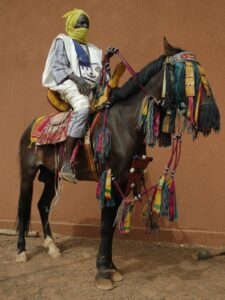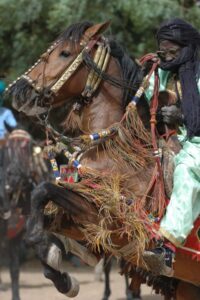Over the last fifty years motorbikes have replaced horses as a means of transport and the fine technique of weaving leather into reins and tassles has almost disappeared in Burkina Faso.
Occasionally a moodibo, a religious teacher, might ride into a village on horseback, tassles flying, with an entourage of garibous (Qu’ranic students) in tow. But this spectacle is getting less common. Even the proudest riders in Fulani culture are swapping their hairy horses for mechanical horses.
For the Gakou family in Burkina Faso, this trend has spelled disaster for their long tradition of making decorative harnesses for horses. The Gakous belong to the leatherworkers caste of Fulani, known in Fulfulde as Gargasaabe. The men make sandals, amulet pouches (talkuru, plural talki) and knife sheaths. The women make cushions and horse harnesses.
Fatimata and Salamata Gakou – now elderly ladies – were until recently the only women in the family who still knew the technique. The younger women in the village weren’t interested in learning as there didn’t seem much point. These days you can’t make a living from reins alone.
SAHEL design has turned the family business around by applying the same technique for making reins and girth straps to making bag straps. They are strong, beautiful and ideal for this purpose. Just as the tassles were used to enhance the movement of a horse, they also add flirtatious detail to a functional accessory. In the spirit of tradition we have plans to make saddlebags for mechanical horses too.
The specialist skills required to make a full horse complet are impressive. It has taken years for Salamata and Fatimata to reach the standard of work that has earned them the reputation as the best reins makers in the region. Now their legacy can live on, because the younger women are beginning to learn their skills.
A horse complet (pictured below left) consists of one set of reins (karbajuruwol) and a pair of side reins (boggerde), stirrup leathers (boggi keebeeje) and a girth (nukure). A complet takes about 15 full days to make from start to finish and uses 10 goat skins. The bags and belts in the SAHEL collection use custom made lengths of the different braiding styles deployed in a horse complet.




